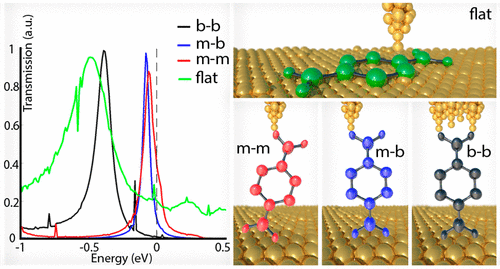当前位置:
X-MOL 学术
›
J. Phys. Chem. C
›
论文详情
Our official English website, www.x-mol.net, welcomes your
feedback! (Note: you will need to create a separate account there.)
Combined Impact of Denticity and Orientation on Molecular-Scale Charge Transport
The Journal of Physical Chemistry C ( IF 3.3 ) Pub Date : 2020-04-17 , DOI: 10.1021/acs.jpcc.9b10566 Parisa Yasini 1 , Stuart Shepard 2 , Tim Albrecht 3 , Manuel Smeu 2 , Eric Borguet 1
The Journal of Physical Chemistry C ( IF 3.3 ) Pub Date : 2020-04-17 , DOI: 10.1021/acs.jpcc.9b10566 Parisa Yasini 1 , Stuart Shepard 2 , Tim Albrecht 3 , Manuel Smeu 2 , Eric Borguet 1
Affiliation

|
Reducing the dimensions of electronic devices to the nanoscale is an important objective with significant scientific and technical challenges. In molecule-based approaches, the orientation of the molecule and coordination to electrodes (denticity) can dramatically affect the electrical properties of the junction. Typically, higher conductance is associated with shorter transport distances and stronger molecule–electrode coupling; however, this is not always the case, as highlighted in this study. We focused on 7,7,8,8-tetracyanoquinodimethane (TCNQ) and 2,3,5,6-tetrafluoro-7,7,8,8-tetracyanoquinodimethane (F4TCNQ) molecules and have used the scanning tunneling microscopy break junction (STM-BJ) method to measure the electrical conductance of single molecules bridged between gold electrodes with different molecular orientations and with varying denticities. In conjunction with the experiments, density functional theory (DFT) and nonequilibrium Green’s function (NEGF) calculations were performed to determine the conductance of four distinct molecular configurations. The calculated conductances show how different configurations and denticities influence the molecular orbital offsets with respect to the Fermi level and provide assignments for the experimental results. Surprisingly, lower denticity results in higher conductance, with the highest predicted molecular conductance being 0.6 G0, which is explained by the influence of molecule–electrode coupling on the energy of molecular orbitals relative to the Fermi level. These results highlight the importance of molecular geometry and binding configuration of the molecule to the electrode. Consequently, our findings have profound ramifications for applications in which orbital alignment is critical to the efficiency of charge transport, such as in dye sensitized solar cells, molecular switches, and sensors.
中文翻译:

密度和取向对分子尺度电荷传输的综合影响
将电子设备的尺寸减小到纳米级是具有重大科学和技术挑战的重要目标。在基于分子的方法中,分子的方向和与电极的配位(同一性)会极大地影响结的电性能。通常,更高的电导率与更短的传输距离和更强的分子-电极耦合有关。但是,正如本研究强调的那样,情况并非总是如此。我们专注于7,7,8,8-四氰基喹二甲烷(TCNQ)和2,3,5,6-四氟-7,7,8,8-四氰基喹二甲烷(F 4TCNQ)分子,并已使用扫描隧道显微镜断裂结(STM-BJ)方法来测量桥接在具有不同分子取向和不同密度的金电极之间的单个分子的电导率。结合实验,进行密度泛函理论(DFT)和非平衡格林函数(NEGF)计算,以确定四种不同分子构型的电导。计算出的电导表明不同的构型和密度如何相对于费米能级影响分子轨道的偏移,并为实验结果提供依据。出乎意料的是,较低的密度会导致较高的电导,而最高的预测分子电导为0.6 G 0,这可以通过分子电极耦合对相对于费米能级的分子轨道能量的影响来解释。这些结果突出了分子几何形状和分子与电极的结合构型的重要性。因此,我们的发现对于在诸如染料敏化太阳能电池,分子开关和传感器等轨道对准对于电荷传输效率至关重要的应用中具有深远的意义。
更新日期:2020-04-24
中文翻译:

密度和取向对分子尺度电荷传输的综合影响
将电子设备的尺寸减小到纳米级是具有重大科学和技术挑战的重要目标。在基于分子的方法中,分子的方向和与电极的配位(同一性)会极大地影响结的电性能。通常,更高的电导率与更短的传输距离和更强的分子-电极耦合有关。但是,正如本研究强调的那样,情况并非总是如此。我们专注于7,7,8,8-四氰基喹二甲烷(TCNQ)和2,3,5,6-四氟-7,7,8,8-四氰基喹二甲烷(F 4TCNQ)分子,并已使用扫描隧道显微镜断裂结(STM-BJ)方法来测量桥接在具有不同分子取向和不同密度的金电极之间的单个分子的电导率。结合实验,进行密度泛函理论(DFT)和非平衡格林函数(NEGF)计算,以确定四种不同分子构型的电导。计算出的电导表明不同的构型和密度如何相对于费米能级影响分子轨道的偏移,并为实验结果提供依据。出乎意料的是,较低的密度会导致较高的电导,而最高的预测分子电导为0.6 G 0,这可以通过分子电极耦合对相对于费米能级的分子轨道能量的影响来解释。这些结果突出了分子几何形状和分子与电极的结合构型的重要性。因此,我们的发现对于在诸如染料敏化太阳能电池,分子开关和传感器等轨道对准对于电荷传输效率至关重要的应用中具有深远的意义。


















































 京公网安备 11010802027423号
京公网安备 11010802027423号